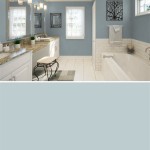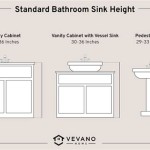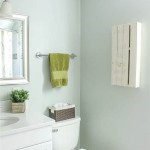Bathroom Vanity Small With Sink: Maximizing Space and Style
Small bathrooms present unique design challenges, often requiring creative solutions to optimize functionality and aesthetics. A bathroom vanity with a sink specifically designed for smaller spaces is a crucial element in achieving both. These vanities offer a compact storage solution while integrating essential plumbing fixtures, contributing to an organized and visually appealing bathroom. The selection process requires careful consideration of dimensions, style, storage needs, and material choices.
The primary function of a bathroom vanity is to provide a dedicated space for handwashing and personal hygiene. Beyond this practical aspect, it serves as a focal point within the bathroom, influencing the overall design and atmosphere. A well-chosen vanity can enhance the perceived size of the room, improve storage capacity, and complement the existing décor, ultimately contributing to a more comfortable and functional bathroom environment.
Navigating the market for small bathroom vanities with sinks involves understanding the various types available, their respective advantages and disadvantages, and the key factors that contribute to making an informed purchasing decision. This exploration will cover aspects such as size limitations, mounting styles, material selection, storage options, and considerations for plumbing compatibility.
Understanding Size Constraints and Vanity Dimensions
The most critical factor in selecting a small bathroom vanity is the available space. Precise measurements are essential to avoid overcrowding the bathroom and hindering movement. Standard bathroom vanity depths typically range from 16 to 22 inches, while widths can vary significantly. For very small bathrooms, vanities as narrow as 18 inches wide may be necessary. It is crucial to measure the width, depth, and height of the intended installation area, taking into account any obstructions such as door swings, toilet placement, and existing plumbing.
When measuring, consider the necessary clearance around the vanity. A minimum of 24 inches of clear space in front of the vanity is recommended for comfortable use. Additionally, ensure adequate side clearance, particularly if the vanity is positioned between two walls or adjacent to other fixtures. Failure to accurately measure and account for clearance can result in a cramped and uncomfortable bathroom layout.
While minimizing dimensions is important in small spaces, it's also vital to consider the sink size. A smaller vanity often equates to a smaller sink basin, which may compromise functionality. Evaluate the depth and width of the sink to ensure it is adequate for everyday use without causing excessive splashing. Options such as corner sinks or wall-mounted faucets can help maximize space without sacrificing sink size significantly.
Exploring Different Mounting Styles: Floor-Mounted vs. Wall-Mounted
Bathroom vanities are generally available in two primary mounting styles: floor-mounted and wall-mounted (also known as floating) vanities. Each style offers distinct advantages and disadvantages, particularly relevant in small bathroom settings. The choice depends on factors such as desired aesthetics, storage needs, and plumbing considerations.
Floor-mounted vanities are the more traditional and commonly used option. They rest directly on the floor, providing inherent stability and often offering more substantial storage capacity. These vanities typically feature enclosed cabinets or open shelving for storing toiletries, towels, and other bathroom essentials. However, floor-mounted vanities can visually weigh down a small bathroom, making it appear more cramped.
Wall-mounted vanities, on the other hand, create a sense of spaciousness by lifting the vanity off the floor. This design allows for easier cleaning underneath the vanity and can make a small bathroom feel larger and more open. Wall-mounted vanities can be particularly beneficial in bathrooms with limited floor space, as they free up visual space and create a more streamlined aesthetic. However, installation requires secure wall mounting, and storage capacity may be somewhat limited compared to floor-mounted options. Plumbing connections also require careful planning and execution for wall-mounted installations.
When selecting between floor-mounted and wall-mounted vanities, consider the structural integrity of the wall. Wall-mounted vanities require adequate reinforcement to support the weight of the vanity and its contents. If the wall is not sufficiently sturdy, additional support may be necessary, potentially adding to the installation cost and complexity. Furthermore, evaluate the existing plumbing configuration to ensure compatibility with the chosen mounting style.
Material Considerations: Durability, Aesthetics, and Maintenance
The material of a bathroom vanity significantly impacts its durability, aesthetics, and maintenance requirements. Common materials include wood, MDF (medium-density fiberboard), plywood, ceramic, stone, and various composites. Each material has its own set of advantages and disadvantages, making it crucial to select a material that aligns with both functional needs and aesthetic preferences.
Solid wood is a classic choice, offering durability and a timeless aesthetic. Wood vanities can withstand moisture and wear and tear with proper sealing and maintenance. However, solid wood can be more expensive than other options and may be susceptible to warping or cracking in humid environments if not properly treated. Common wood species used for vanities include oak, maple, and cherry.
MDF is a cost-effective alternative to solid wood, offering a smooth surface that is ideal for painting or laminating. MDF is less prone to warping than solid wood but is also more susceptible to moisture damage. MDF vanities typically require a durable finish to protect them from water spills and humidity. Plywood is another engineered wood product that offers better moisture resistance than MDF and is often used for cabinet construction.
Ceramic and stone are commonly used for vanity tops and sinks. Ceramic is durable, easy to clean, and resistant to stains and scratches. Stone options such as granite and marble offer a luxurious aesthetic but can be more expensive and require specific cleaning products to maintain their appearance. Composite materials, such as quartz, provide a balance of durability, aesthetics, and ease of maintenance.
When selecting a vanity material, consider the overall design style of the bathroom and the desired level of maintenance. For high-traffic bathrooms or those prone to moisture, materials with excellent water resistance and easy-to-clean surfaces are recommended. Properly sealing and maintaining the vanity will extend its lifespan and preserve its appearance.
Storage Solutions: Maximizing Functionality in Limited Space
Effective storage is paramount in small bathrooms. A well-designed vanity should provide ample storage space for toiletries, towels, and other bathroom essentials without compromising the available floor space. Various storage solutions can be incorporated into small bathroom vanities to maximize functionality.
Drawers are an excellent way to organize smaller items, such as makeup, skincare products, and hair accessories. Opt for vanities with multiple drawers or tiered drawer systems to maximize storage capacity. Drawer dividers and organizers can further enhance organization and prevent items from shifting during use.
Cabinets provide larger storage spaces for towels, cleaning supplies, and other bulky items. Consider vanities with adjustable shelves to customize the storage configuration to suit specific needs. Installing door-mounted organizers or pull-out shelves can further enhance the accessibility and organization of cabinet contents.
Open shelving can be used to display decorative items or store frequently used items, such as hand towels and washcloths. Open shelving can also create a sense of spaciousness and visual interest in a small bathroom. However, open shelving requires regular cleaning and organization to prevent clutter from accumulating.
In addition to traditional drawers and cabinets, consider incorporating other storage solutions, such as towel bars, hooks, and over-the-toilet storage units. These accessories can help maximize storage space without taking up valuable floor space. Wall-mounted organizers and shelves can also be used to store toiletries and accessories.
Plumbing Considerations: Compatibility and Installation
Plumbing compatibility is a crucial aspect of selecting and installing a small bathroom vanity with a sink. Ensure that the vanity is compatible with the existing plumbing configuration, including the water supply lines, drain line, and faucet connections. Consult with a qualified plumber if necessary to ensure proper installation and avoid potential plumbing issues.
Consider the location of the water supply lines and drainpipe when selecting a vanity. The vanity should have cutouts or openings that align with these existing plumbing connections. If the plumbing connections are not in the correct location, modifications may be necessary, which can add to the installation cost and complexity.
The drainpipe connection should be properly sealed to prevent leaks and ensure proper drainage. Use plumber's putty or Teflon tape to seal the connection between the sink drain and the drainpipe. Ensure that the drainpipe has a P-trap to prevent sewer gasses from entering the bathroom.
When installing a faucet, follow the manufacturer's instructions carefully. Ensure that the faucet connections are properly tightened to prevent leaks. Use Teflon tape or pipe dope to seal the connections between the faucet and the water supply lines. Consider the height and reach of the faucet spout to ensure it is compatible with the sink basin.
If you are not comfortable with plumbing installations, it is best to hire a qualified plumber to install the vanity. A professional plumber can ensure that the vanity is properly installed and that all plumbing connections are secure and leak-free.

Bathroom Vanity Ideas The Home

Bathroom Vanity Sink Base

Buy Rustic Chunky Solid Wood Bathroom Washstand Vanity Sink Unit Small 4 Sizes Not Included Sinks Taps Baskets In

Bathroom Vanity Cabinet At 3000 Piece Cabinets In New Delhi Id 2853923993948

Pvc Vanity Cabinets Bathroom Wash Basin With Modern Deisgn And Mgawe

Bathroom Vanity 24 Inch Small Bath With Sink Modern Cabi

Buy Solid Oak Bathroom Cabinet Small Vanity Units Mirror Sink 300cbc351 In

Nameeks Mini5 Bathroom Vanity Mini Nameek S

Aoibox 24inch White Bathroom Vanity Sink Combo For Small Space Modern Design With Ceramic Basin Gold Legs And Semi Open Storage Snsa11in153

24 Inch Brown Classic Style Powder Room Debellis Small Bathroom Vanity Chans Furniture
See Also







